Plunging Into Perl While Avoiding the Deep End (mostly)
- 1. Plunging Into Perl While Avoiding the Deep End (mostly)
- 2. Some Perl nomenclature PERL – Practical Extraction and Report Language
- 3. Some Perl nomenclature PERL – Practical Extraction and Report Language PERL – Pathologically Eclectic Rubbish Lister (if you’re so inclined)
- 4. Some Perl nomenclature PERL – Practical Extraction and Report Language PERL – Pathologically Eclectic Rubbish Lister (if you’re so inclined) TMTOWTDI – There’s More Than One Way To Do It
- 5. Some Perl attributes it’s a scripted language, not compiled - faster, easier development runs plenty fast for most things
- 6. Some Perl attributes it’s a scripted language, not compiled - faster, easier development runs plenty fast for most things Loose variable typing - both good and bad, but mostly good
- 7. Your first program #!/usr/local/bin/perl print "Hello, World\n";
- 8. “Protecting” your program (Unix) By default, your program is not executable. chmod 744 your_program You can execute it as owner of the file, anyone else can only read it.
- 9. Variables $name can be text or number: a character, a whole page of text, or any kind of number context determines type can go “both” ways
- 10. Variables, array of @employee Array of $employee variables $employee[0] $employee[1] etc.
- 11. Variables, hash of $lib{‘thisone’} = “2 days”; $lib{‘thatone’} = “5 days”; Thus can use $grace_period = $lib{$libname} when $libname is thatone, $grace_period is 5 days
- 12. Variables, list of ($var1, $var2, $var3) = function_that_does_something; This function returns a list of elements. A list is always inside parentheses ().
- 13. Variables, assigning a value to $var = value or expression $array[n] = something; @array = (); # empty array %hash = (); # empty hash Can be done almost anywhere, anytime.
- 14. Variable scope, and good practices use strict; Requires that you declare all variables like this: my $var; my $var = something; my @array = (); Also makes Perl check your code. Best Practices!
- 15. Variable scope, and good practices use strict; my $var; my $var = something; my @array = (); A variable declared like this is visible throughout your program. Best Practices!
- 16. Variable scope, and good practices use strict; my $var; my $var = something; my @array = (); A “my” declaration within code grouped within { and } is visible only in that section of code; it does not exist elsewhere. Best Practices! Scope: where in a program a variable exists.
- 17. File input and output (I/O)
- 18. Using command line arguments Usage: program.pl infile outfile $ARGV[0] $ARGV[1]
- 19. String manipulation & other stuff substring function
- 20. String manipulation & other stuff a better substring example
- 21. String manipulation & other stuff index function, find the location of a string in a string
- 22. String manipulation & other stuff The split function. Here we split string $l into pieces at every space character. Less common usage: take only 1 st 2 pieces.
- 23. String manipulation & other stuff Actually, the 2 nd statement should be: $l =~ s/^ +//; The ^ means start looking at the start of the line. find “db ratio” anywhere in $l
- 24. String manipulation & other stuff Instead of using $inline[n], $inline[n+1], etc., to refer to elements of array @inline , here we can refer to @inline’s elements via $l in this example. Often makes for clearer and simpler code.
- 25. String manipulation & other stuff An often convenient way of populating an array.
- 26. String manipulation & other stuff Given $stuff = “this is me”; These are not equivalent: “ print $stuff” ‘ print $stuff’ `print $stuff`
- 27. String manipulation & other stuff Given $stuff = “this is me”; These are not equivalent: “ print $stuff” is “print this is me” ‘ print $stuff’ `print $stuff`
- 28. String manipulation & other stuff Given $stuff = “this is me”; These are not equivalent: “ print $stuff” is “print this is me” ‘ print $stuff’ is ‘print $stuff’ `print $stuff`
- 29. String manipulation & other stuff Given $stuff = “this is me”; `print $stuff` would have the operating system try to execute the command <print this is me>
- 30. String manipulation & other stuff This form should be used as $something = `O.S. command` Example: $listing = ‘ls *.pl`; The output of this ls command is placed, as possibly a large string, into the variable $listing. This syntax allows powerful processing capabilities within a program.
- 31. printf, sprintf printf(“%s lines here”, $counter) if $counter is 42, we get 42 lines here for the output
- 32. printf, sprintf printf(“%c lines here”, $counter) if $counter is 42, we get * lines here for the output, since 42 is the ASCII value for “*”, and we’re printing a c haracter
- 33. printf, sprintf Some additional string formatting… %s – output length is length($var) %10s – output length is absolutely 10 (right justified) %10.20s – output length is min 10, max 20 %-10.10s – output length is absolutely 10 (left justified) Any padding is with space characters.
- 34. printf, sprintf Some additional number formatting… %d – output length is length($var) %10d – output length is absolutely 10 (leading space padded) %-10d – left justified, absolutely 10 (trailing space padded) %-10.10d – right justified, absolutely 10 (leading zero padded)
- 35. printf, sprintf Still more number formatting… %f – output length is length($var) %10.10f – guarantees 10 positions to the right of the decimal (zero padded)
- 36. printf, sprintf printf whatever outputs to the screen
- 37. printf, sprintf printf whatever outputs to the screen printf file whatever outputs to that file Ex: printf file (“this is %s fun\n”, $much); ( print functions just like the above, as to output destination.)
- 38. printf, sprintf printf whatever outputs to the screen printf file whatever outputs to that file Ex: printf file (“this is %s fun\n”, $much); ( print functions just like the above, as to output destination.) sprintf is just like any printf, except that its output always goes to a string variable. Ex: $var = sprintf(“this is %s fun\n”, $much);
- 39. ratiocheck.pl, what it does When the ratio of sizes of certain files related to a database exceeds a threshold, it’s probably time to do an index regen on that database.
- 40. ratiocheck.pl, what it does When the ratio of sizes of certain files related to a database exceeds a threshold, it’s probably time to do an index regen on that database. This program computes these ratios for several databases, each with its own threshold, and flags those that are candidates for index regeneration.
- 41. program dissection – ratiocheck.pl set up some variables two of these are templates for printing
- 42. program dissection – ratiocheck.pl In line 3 above, a file is slurped, i.e., the entire file is read into an array via the <> mechanism.
- 43. program dissection – ratiocheck.pl This is a more typical use of the split function. Here, $item is separated into two pieces at the “|” character.
- 44. program dissection – ratiocheck.pl We want to check every database in alphabetical order. We are then calling the checkit subroutine for each database.
- 45. program dissection – ratiocheck.pl The system function executes its string as an O.S. command. Here we are mailing a file to two different people.
- 46. program dissection – ratiocheck.pl This subroutine takes 1 argument.
- 47. program dissection – ratiocheck.pl Remember our generic templates? Here they are used as a format string for the sprintf function. $generic_path = "/m1/voyager/%s/data/";
- 48. program dissection – ratiocheck.pl The –s test returns a file’s size. (There are several dozen different –x file tests.)
- 49. program dissection – ratiocheck.pl Compute the files’ size ratio with sufficient decimal places.
- 50. program dissection – ratiocheck.pl \n means new line , loosely equivalent to a CR, or carriage return. Since we want to print the “%” character, we have to escape it with the “\” backslash.
- 51. program dissection – ratiocheck.pl Here we have a hash reference… we are checking if the ratio is greater than the threshold for the current database.
- 52. program dissection – ratiocheck.pl This is a busy printf statement… the alert text gets a string, a character, and a string embedded in it .
- 53. program dissection – ratiocheck.pl The first argument is a string, which is the output of the sprintf statement, which outputs the threshold value for this database.
- 54. program dissection – ratiocheck.pl The second argument is a character. We print the “%” character, whose ASCII value is 37.
- 55. program dissection – ratiocheck.pl The third argument is a string. In this case, the string consists of 35 asterisks. A string followed by “xN” will occur N times.
- 56. ratiocheck.pl, output Here’s what the output looks like:
- 57. DBI stuff What is it and why might I want it? DBI is the DataBase Interface module for Perl. You will also need the specific DBD (DataBase Driver) module for Oracle. This enables Perl to perform queries against your Voyager database. Both of these should already be on your Voyager box.
- 58. DBI stuff, how to You need four things to connect to Voyager: machine name your.machine.here.edu username your_username password your_password SID VGER (or LIBR)
- 59. DBI stuff, how to $dbh is the handle for the database $sth is the handle for the query Create a query…then execute it. NOTE: SQL from Access will most likely NOT work here!
- 60. DBI stuff, how to Get the data coming from your query.
- 61. DBI stuff, how to Get the data coming from your query. You’ll need a Perl variable for each column returned in the query. Commonly a list of variables is used; you could also use an array.
- 62. DBI stuff, how to Get the data coming from your query. You’ll need a Perl variable for each column returned in the query. Commonly a list of variables is used; you could also use an array. Typically, you get your data in a while loop, but you could have $var = $sth->fetchrow_array; when you know you’re getting a single value.
- 63. DBI stuff, how to When you’re done with a query, you should finish it. This becomes important when you have multiple queries in succession. You can have multiple queries open at the same time. In that case, make the statement handles unique…$sth2, or $sth_patron. Finally, you can close your database connection.
- 64. CPAN Comprehensive Perl Archive Network http://cpan.org You name it and somebody has probably written a Perl module for it, and you’ll find it here. There are also good Perl links here; look for the Perl Bookmarks link.
- 65. CPAN Installing modules You need to be root for systemwide installation on Unix systems. On Windows machines, you’ll need to be administrator. You can install them “just for yourself” with a bit of tweaking, and without needing root access. If you’re not a techie, you’ll probably want to find someone who is, to install modules. Installing modules is beyond the scope of this presentation.
- 66. Perl on your PC You can get Perl for your PC from ActiveState. They typically have two versions available; I recommend the newer one. Get the MSI version. Installation is easy and painless, but it may take some time to complete. A lot of modules are included with this distribution; many additional modules are available. Module installation is made easy via the Perl Package Manager (PPM). Modules not found this way will require manual installation, details of which are beyond the scope of this presentation.
- 67. Date and Time in Perl, basic ### "create" today's date my ($sec, $min, $hour, $day, $month, $year, $wday, $yday, $isdst) = localtime; This gets the date and time information from the system.
- 68. Date and Time in Perl, basic ### "create" today's date my ($sec, $min, $hour, $day, $month, $year, $wday, $yday, $isdst) = localtime; my $today = sprintf ("%4.4d.%2.2d.%2.2d", $year+1900, $month+1, $day); This puts today’s date in “Voyager” format, 2006.04.26
- 69. Date and Time in Perl The program, datemath.pl, is part of your handout. The screenshot below shows its output.
- 70. Regular expressions, matching m/PATTERN/gi If the m for matching is not there, it is assumed. The g modifier means to find globally, all occurrences. The i modifier means matching case insensitive. Modifiers are optional; others are available.
- 71. Regular expressions, substituting s/PATTERN/REPLACEWITH/gi The s says that substitution is the intent. The g modifier means to substitute globally, all occurrences. The i modifier means matching case insensitive. Modifiers are optional; others are available.
- 72. Regular expressions, translating tr/SEARCHFOR/REPLACEWITH/cd The tr says that translation is the intent. The c modifier means translate whatever is not in SEARCHFOR. The d modifier means to delete found but unreplaced characters. Modifiers are optional; others are available.
- 73. Regular expressions Look in the Perl book (see Resources) for an explanation on how to use regular expressions. You can look around elsewhere, at Perl sites, and in other books, for more information and examples. Looking at explained examples can be very helpful in learning how to use regular expressions. (I’ve enclosed some I’ve found useful; see Resources.)
- 74. Regular expressions Very powerful mechanism. Often hard to understand at first glance. Can be rather obtuse and frustrating! If one way doesn’t work, keep at it. Most likely there is a way that works!
- 75. Resources Advanced Perl Programming Learning Perl Perl in a Nutshell Programming Perl Perl Cookbook Perl Best Practices I use these two a lot Highly recommended once you’re experienced. These are all O’Reilly books.
- 76. Resources CPAN http://cpan.org Active State Perl http://activestate.com/Products/Download/Download.plex?id=ActivePerl The files listed below are available at http://homepages.wmich.edu/~zimmer/files/eugm2006 datemath.pl some program code for math with dates snippet.grep various regular expressions I’ve found useful Plunging Into Perl.ppt this presentation
- 77. Thanks for listening. Questions? [email_address] 269.387.3885 Picture © 2005 by Roy Zimmer






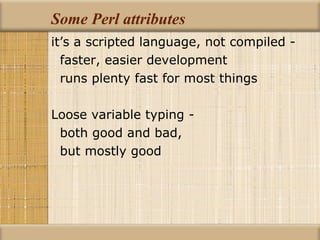



![Variables, array of @employee Array of $employee variables $employee[0] $employee[1] etc.](https://image.slidesharecdn.com/plungingintoperl-100115141506-phpapp01/85/Plunging-Into-Perl-While-Avoiding-the-Deep-End-mostly-10-320.jpg)

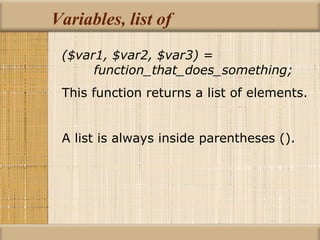
![Variables, assigning a value to $var = value or expression $array[n] = something; @array = (); # empty array %hash = (); # empty hash Can be done almost anywhere, anytime.](https://image.slidesharecdn.com/plungingintoperl-100115141506-phpapp01/85/Plunging-Into-Perl-While-Avoiding-the-Deep-End-mostly-13-320.jpg)




![Using command line arguments Usage: program.pl infile outfile $ARGV[0] $ARGV[1]](https://image.slidesharecdn.com/plungingintoperl-100115141506-phpapp01/85/Plunging-Into-Perl-While-Avoiding-the-Deep-End-mostly-18-320.jpg)
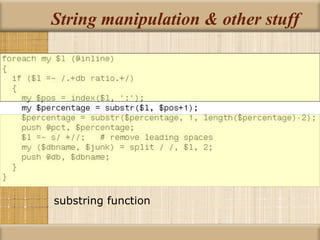

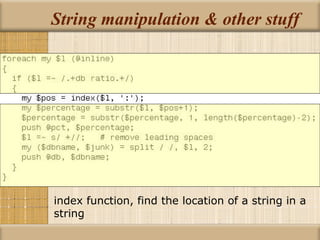


![String manipulation & other stuff Instead of using $inline[n], $inline[n+1], etc., to refer to elements of array @inline , here we can refer to @inline’s elements via $l in this example. Often makes for clearer and simpler code.](https://image.slidesharecdn.com/plungingintoperl-100115141506-phpapp01/85/Plunging-Into-Perl-While-Avoiding-the-Deep-End-mostly-24-320.jpg)





















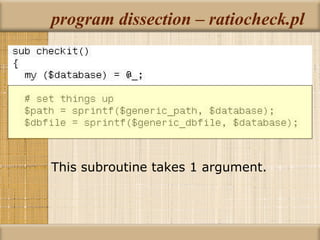
























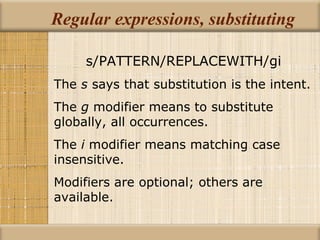


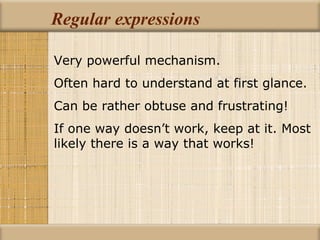

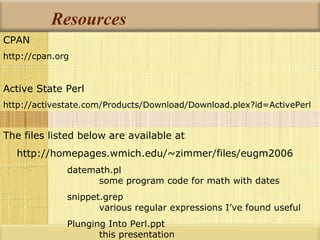
![Thanks for listening. Questions? [email_address] 269.387.3885 Picture © 2005 by Roy Zimmer](https://image.slidesharecdn.com/plungingintoperl-100115141506-phpapp01/85/Plunging-Into-Perl-While-Avoiding-the-Deep-End-mostly-77-320.jpg)